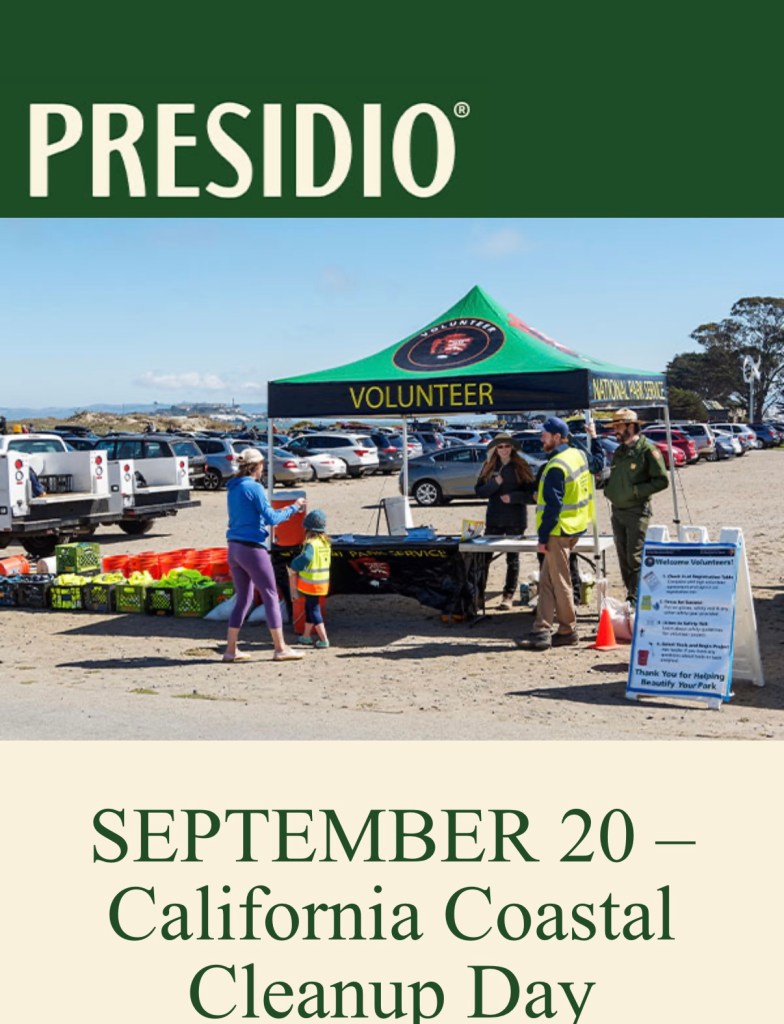What’s New This Fall at the Presidio
What’s New This Fall at the Presidio
Fall has arrived at the Presidio, bringing a fresh lineup of events, seasonal experiences, and new ways to connect with nature—and each other—in the park.
Reserve the Outpost Meadow Picnic Pods
Reserve your picnic “pod” at the new Outpost Meadow at recreation.gov starting October 1 (available on a two-month rolling basis). Two picnic pods with 5-7 picnic tables each, including those that are accessible, are available to reserve, guaranteeing space for your next large gathering. One picnic pod contains two double BBQ grills, for a total of four grilling surfaces, and several have umbrellas for shade. The Outpost Meadow, adjacent to the Outpost playground, opened in July 2025 and has been a huge hit, especially for families coming to enjoy the nearby play space and waterfront.
Volunteer in the Park
The Presidio Trust and its partners, the National Park Service and Golden Gate National Parks Conservancy, provide ongoing opportunities to help steward our parks, spend time outdoors, and meet other volunteers. See the website for weekly programs and consider participating in our bigger events—like planting season in December. Check out this page for updates and to register.
Fall Events – Just Announced!
The Presidio is pleased to partner with wonderful organizations to host entertainment and cultural festivals that welcome all.
Chuseok Festival 2025
When: Saturday, September 27, 11 a.m. to 4 p.m.
Where: Main Parade Lawn
Cost: Free
Link: https://presidio.gov/explore/events/chuseok-festival-2025
What: Join Korean Center Inc. for the 7th annual Chuseok Festival. This is the Bay Area’s largest public event celebrating Korean culture, community, and tradition. The vibrant cultural event brings bold flavors, rhythmic performances, and community connections honoring Korea’s cherished harvest holiday.
San Francisco Amateur Astronomers Star Party
When: Saturday, October 4, 6 p.m. to 9 p.m. and Saturday, November 1, 4, 6 p.m. to 9 p.m.
Where: Presidio Tunnel Tops, 210 Lincoln Boulevard, San Francisco, CA 94129
Cost: Free
Link: https://presidio.gov/explore/events/san-francisco-amateur-astronomers-star-parties-april/2025-10-04
What: Join the San Francisco Amateur Astronomers (SFAA) for free public stargazing of the Moon, planets, globular clusters, and more! Dress warmly as conditions can be windy or cold in the Presidio. Rain, heavy fog, or overcast skies cancel the event. Check the SFAA website for a cancellation notice before leaving for the star party.
NEW! Oktoberfest in the Presidio
When: Every Thursday throughout October (10/9, 10/16, 10/23, and 10/30) from 4 p.m. to 7 p.m.
Where: Picnic Pavilion at Presidio Tunnel Tops, 215 Lincoln Boulevard, San Francisco, CA 94129
Cost: Food and beverages for purchase
What: Il Parco and Fort Point team up to bring you a month of Oktoberfest festivities in the Picnic Pavilion at Presidio Tunnel Tops. Enjoy German food specials by Il Parco, draft beer poured by Fort Point, and live music on Thursdays in October.Stop by for a post-work happy hour or fun family afternoon – lederhosen encouraged!
Fleet Week: 191st Army Reserve Rock Band Concert
When: Friday, October 10, 12:00 p.m. and 2:00 p.m.
Where: Presidio Tunnel Tops, 210 Lincoln Boulevard, San Francisco, CA 94129
Cost: Free
Link: https://presidio.gov/explore/events/fleet-week-concert
What: Kick off Fleet Week at the Presidio with the 191st Army Reserve Rock Band, which brings high-energy rock and pop hits to Presidio Tunnel Tops. Pack a picnic, grab a blanket, and enjoy an afternoon of live music with the Golden Gate Bridge as your backdrop.
Sundown Cinema: Edward Scissorhands
When: Thursday, October 23, 6 p.m.
Where: Civil War Parade Ground, Graham Street, San Francisco, CA 94129
Cost: Free
Link: https://sfstandard.com/2025/09/09/sundown-cinema/
What: Enjoy cinema under the stars! Edward Scissorhands (PG-13) is a modern-day suburban fairy tale starring Johnny Depp. Edward’s unconventional charm shines through as he styles hair, reimagines gardens, and grooms dogs with shears of metal where his fingers should have been. Presented by the San Francisco Standard.
Birds by the Bay: San Francisco’s World Migratory Bird Day Celebration
When: Saturday, October 25, 9 a.m.-12:30 p.m.
Where: Fort Scott Parade Ground, 1388 Storey Avenue, San Francisco, CA 94129
Cost: Free
What: This event highlights the incredible journeys of migratory birds and the importance of creating bird-friendly cities and communities. The all-ages activity is designed to engage families, bird enthusiasts, and community members alike. Presented by the Presidio Trust and the Urban Bird Treaty partnership, it will feature:
- Volunteer habitat restoration projects led by Presidio Trust Natural Resources (check back for a sign-up link)
- Guided bird walks by Golden Gate Bird Alliance for all skill levels.
- Interactive partner tables with fun, family-friendly activities and information about how to support bird conservation at home and in the city.
Community Arts Market
When: Saturday/Sunday October 25 & 26, 10 a.m.- 4 p.m.
Where: Presidio Tunnel Tops, 210 Lincoln Boulvard, San Francisco, CA 94129
Cost: Free
Link: https://presidio.gov/explore/events/community-arts-market/2025-10-25
What: With a focus on building new cultural infrastructure, Community Arts Market (CAM) supports artists while transforming how public space is used for joy, justice, and economic opportunity. From handcrafted goods to cultural storytelling, the family-friendly CAM event showcases the richness and resilience of the Bay Area’s creative communities. Presented by Arts.Co.Lab and hosted by the Presidio.
- 20+ artists, makers, and wellness vendors
- Live music, poetry, and spoken word on a curated stage
- Community gathering Wellness activations and healing spaces
- Accessibility-centered programming and layout
Día de los Muertos & Diwali in the Parks
When: Saturday, November 1, 11 a.m. – 3 p.m.
Where: Presidio Tunnel Tops, 210 Lincoln Boulevard, San Francisco, CA 94129
Cost: Free
Link: https://presidio.gov/explore/events
Celebrate cultural holidays Día de los Muertos & the Diwali Festival of Lights in the Presidio! Enjoy arts and crafts, face painting, henna tattoos, planting native plants and more as we come together to honor ancestral traditions in the park. Visitors can bring a photo of their loved ones to contribute to the Tree of Life Ofrenda in the Presidio Visitor Center.
Ongoing: See the events calendar at www.presidio.gov/events for information on Park Ranger Campfire Talks, History Talks, and Park Overviews. Visit the Black Gold: Stories Untold exhibition at Fort Point through November 2, by FOR-SITE in partnership with the Golden Gate National Parks Conservancy. The Walt Disney Family Museum and Presidio Theatre, the Interfaith Center at the Presidio, also present fall events. Check their websites for details.
Fall Hours of Operation Through November 1
Presidio Pop Up (mobile food): Daily, weekends from 9 a.m. to 5:30 p.m.; weekdays 9 a.m. to 3 p.m.
Outpost Nature Play Area: 9:30 a.m. to 6 p.m., daily
Field Station: Wednesday – Friday, 11 a.m. to 4 p.m.; Saturday – Sunday, 10 a.m. to 5 p.m. (closed Monday and Tuesday)
Presidio Visitor Center: 10 a.m. to 5 p.m. daily
Presidio Officers’ Club History Galleries: Friday, Saturday, Sunday, 11 a.m. – 4 p.m.
For details on transportation to the park visit https://www.presidio.gov/transportation
About the Presidio and the Presidio Trust
The Presidio is one of America’s most visited national park sites, located within the Golden Gate National Recreation Area. Spanning 1,500 acres next to San Francisco’s Golden Gate Bridge, the Presidio is among the most biologically diverse parks in America. Historically a home to native peoples and a military post under three flags, its facilities have been reinvented as museums, restaurants, hotels, homes, and offices. The Presidio Trust is the federal agency that stewards the Presidio, in partnership with the National Park Service and with support from the Golden Gate National Parks Conservancy. The Trust sustains the Presidio by leasing homes and workplaces and offering visitor amenities. More at presidio.gov.
Media Contact:
Lisa Petrie, lpetrie@presidiotrust.gov;
415-264-7787 (m)





